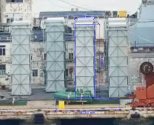That's what I'm wondering about.
The estimated dimension of said VLS modules does look capable of carrying BM and HGV-sized payloads (given that only one missile is carried per module), though certainly not intercontinental range-capable.
More realistically would be BMs and HGVs that are medium range-capable, if not intermediate range-capable.
However, I'm thinking more about the possibility that this cell module being quad-packable, assuming a 2x2 configuration.
Even by taking away the spaces in between the individual VLS cells, there's around 1500mm of VLS cell diameter to boast.
The 850mm UVLS cells doesn't seem to make much sense in this case, because:
1. 2x 850mm cells side-by-side is 1700mm, i.e. huge waste of spacing in between the cells;
2. 3x 850mm cells side-by-side is 2550mm, i.e. again, smaller but still rather large waste of spacing in between the cells (and how would they be arranged inside the 052D's hull, anyway?); and
4. 4x 850mm cells side-by-side is 3400mm, i.e. bigger than the VLS modules in the photo, with zero spacing in between the cells.
VLS cell depth-wise, I think somewhere around 9-10 meters would do (if not 11 meters).
Hence, I'm mystified by this. Something doesn't look right.
Or, conversely - It could just be my (and 大包CG's) poor judgement. They might really just be very normal-looking UVLS modules for the 052Ds - Or perhaps they aren't even VLS modules to begin with (and that we are just overthinking things).


